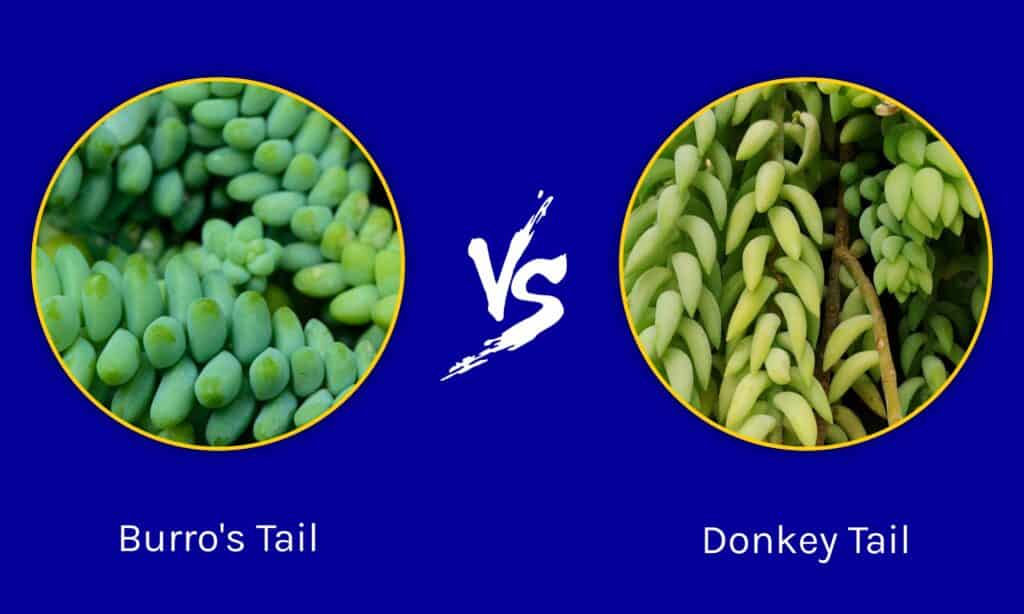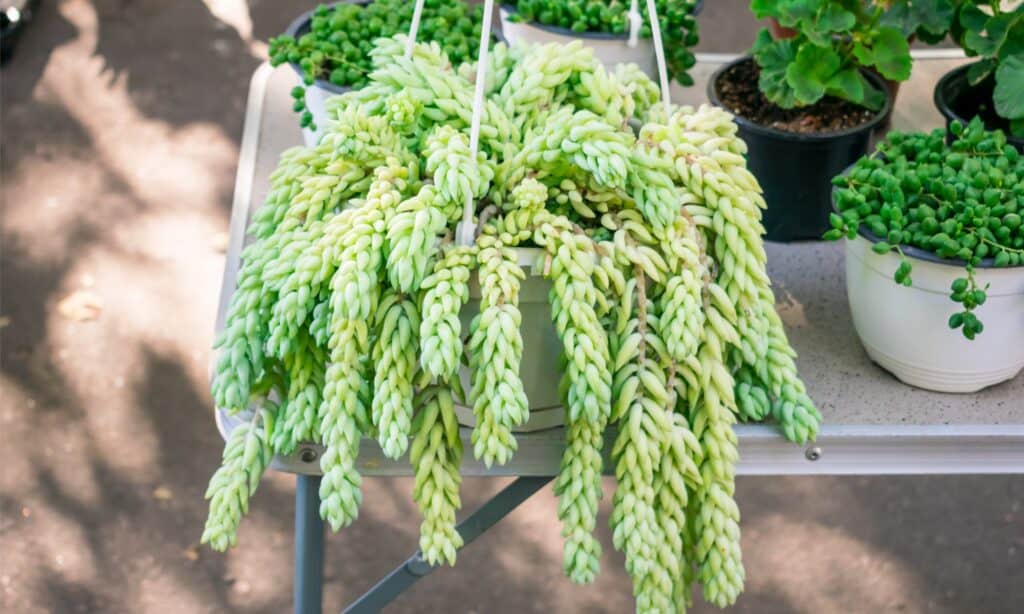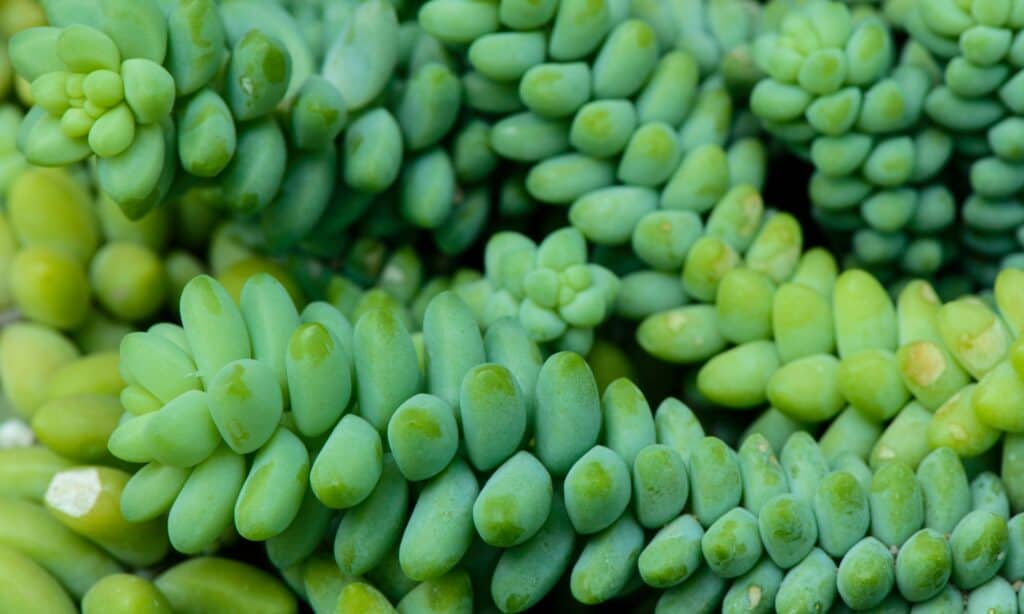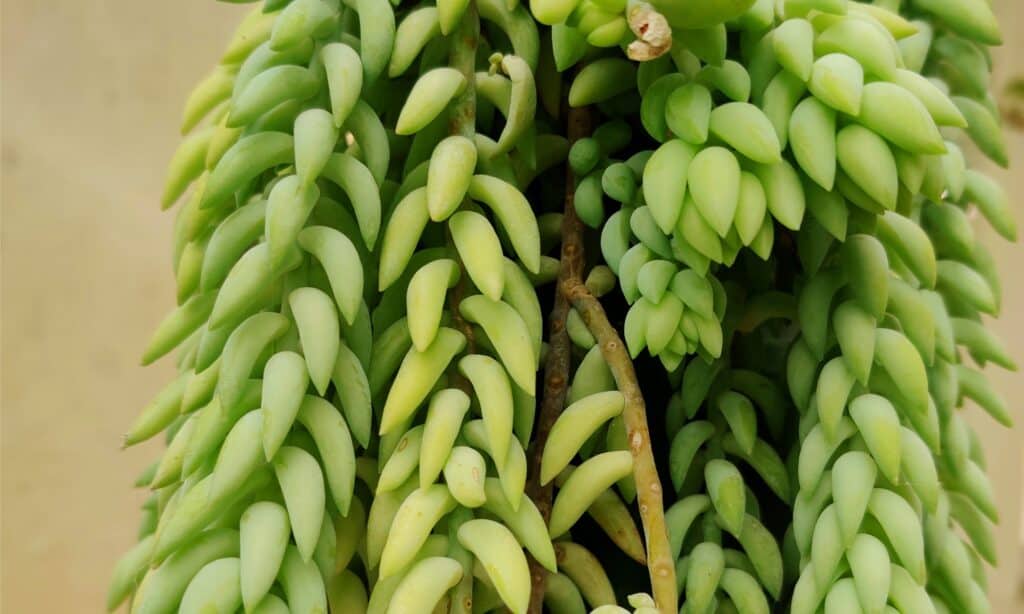Often interchangeable from one another, what are the true differences between a burro’s tail vs donkey tail plant? Are these indeed two separate succulent species, or is this the same type of plant? If you are seeking a new houseplant to add to your home, a burro’s tail or a donkey tail might suit your lifestyle well. But are there any true differences between these plants?
In this article, we will compare a burro’s tail succulent with a donkey tail succulent so that you can fully understand the differences between them. We will go over what they look like physically as well as how you can best grow either of these plants in your own home. Let’s get started and learn about these unique trailing succulents now!
Comparing Burro’s Tail vs Donkey Tail

| Burro’s Tail | Donkey Tail | |
|---|---|---|
| Plant Classification | Sedum morganianum ‘Burrito’ | Sedum morganianum |
| Description | Succulent leaves grow in an oval or beaded shape, top to bottom of each stem. These leaves are a lovely light green color and can be broken off of the stem fairly easily. Plant reaches 3-4 feet long when mature, and produces many trailing stems | Succulent leaves grow in a crescent or c shape, from top to bottom on each individual stem. These leaves are very fragile, breaking off and propagating with ease. Light green in color, growing pinkish blooms in the summertime. Plant reaches maturity with trailing stems that are up to 4 feet long |
| Uses | Extremely popular houseplant since its discovery; ideal for hardiness zones 10-11 but is less fragile compared to donkey tail overall | Extremely popular houseplant since its discovery; ideal for hardiness zones 10-11 |
| Origin and Growing Preferences | Native to Mexico, but not discovered until the 1970s. Care is the same as donkey tail | Native to Mexico, discovered in the 1930s. Prefers full sunlight but nothing too hot to prevent scorching the delicate leaves. Water on occasion, and try not to move this plant too much, to avoid breaking off leaves |
| Name Origins | Often named donkey tail, interchangeably from other sedum varieties! | Named for the unique way this plant trails and grows leaves; looks like a donkey or horse tail as it drapes down! |
Key Differences Between Burro’s Tail vs Donkey Tail

In addition to them being closer together, the leaves of the burro’s tail plant are oval or bead-shaped compared to the crescent or c shape of the donkey tail succulent.
©iStock.com/fottodk
There are a few key differences between burro’s tail and donkey tail plants, but many garden or plant stores label these plants interchangeably. The burro’s tail succulent is a specific variety of the donkey tail plant, both classified as Sedum morganianum. However, many experts suggest that burro’s tail is less fragile than donkey tail, made up of rounded, more compacted leaves compared to the loose, crescent-shaped leaves of the donkey tail plant.
Let’s talk about both of these succulent varieties in more detail now.
Burro’s Tail vs Donkey Tail: Classification
Both classified as Sedum morganianum, there is a lot of debate as to whether or not donkey tail and burro’s tail are separate plants. Often named interchangeably, you might be hard-pressed to tell the difference between these two trailing succulents. However, burro’s tail is often classified as a separate cultivar from donkey tail, earning a “Burrito” to its scientific name. There are enough physical differences between these two succulents to classify them as different varieties from each other, but they are obviously closely related and considered the same plant by a number of people.
Burro’s Tail vs Donkey Tail: Description

The classic donkey tail succulent has leaves that are less compacted compared to the leaves found on the burro’s tail variety of succulent.
©iStock.com/Iryna Imago
It can be incredibly difficult to see the differences between a burro’s tail and a donkey tail plant upon first glance. Both burro’s tail and donkey tail plants produce succulent light green leaves that grow along a trailing stem, from top to bottom. They also both produce pinkish flowers in the summertime when the plant has reached maturity. The donkey tail plant and the burro’s tail plant both reach 3-4 feet long, attractively displayed when these tails are left draped or hanging.
However, there is one key difference between these two sedum cultivars, and it lies in the shape of their leaves. The classic donkey tail succulent has leaves that are less compacted compared to the leaves found on the burro’s tail variety of succulent. In addition to them being closer together, the leaves of the burro’s tail plant are oval or bead-shaped compared to the crescent or c shape of the donkey tail succulent. However, these differences are subtle, so take your time telling them apart!
Burro’s Tail vs Donkey Tail: Uses

You may want to consider the burro’s tail over the donkey tail if you want your plants to be a bit more stable and less likely to break.
©iStock.com/Brostock
Prized for their appearance, burro’s tail and donkey tail are often used interchangeably from each other. These trailing succulents are used primarily as houseplants or outdoor garden accents, but you may want to consider the burro’s tail over the donkey tail if you want your plants to be a bit more stable and less likely to break. While both of these succulent varieties are fragile, the uniquely compacted way in which the burro’s tail grows may give you more stability compared to the fragile donkey tail overall.
Burro’s Tail vs Donkey Tail: Origin and How to Grow
Both of these similar succulent species originated in Mexico, trailing off of cliff sides and thriving in arid regions. However, the donkey tail was originally discovered and popularized in the 1930s, while the burro’s tail variety of this particular succulent was discovered in the 1970s. They both grow in the same way, preferring bright sunlight and a soil mixture with plenty of drainage.
Burro’s Tail vs Donkey Tail: Name Origins

The donkey tail was originally discovered and popularized in the 1930s, while the burro’s tail variety of this particular succulent was discovered in the 1970s.
©iStock.com/Derikjohn
The name origins of both burro’s tail and donkey tail are fairly obvious, given the way in which this plant grows. The delicate trailing stems and leaves resemble horse tails, or donkey tails, often giving this plant its colloquial names. Both of these varieties are also named interchangeably from one another, and you may find that many experts consider them the same plant!
The photo featured at the top of this post is © iStock.com/fottodk
Sources
- Report of a wild population of Sedum morganianum E. Walther (Crassulaceae), Available here: http://www.scielo.org.mx/scielo.php?pid=S0187-71512010000200003&script=sci_abstract&tlng=en
- Notes on Sedum burrito Moran and S. morganianum E.Walther (Crassulaceae) and reinstatement of S. burrito, Available here: https://bioone.org/journals/bradleya/volume-2019/issue-37/brad.n37.2019.a10/Notes-on-iSedum-burrito-i-Moran-and-iS-morganianum-i/10.25223/brad.n37.2019.a10.short
Thank you for reading! Have some feedback for us? Contact the AZ Animals editorial team.






